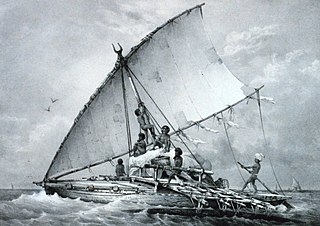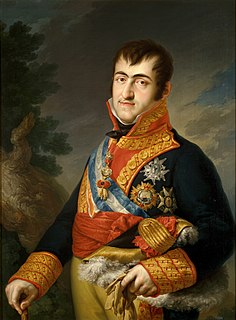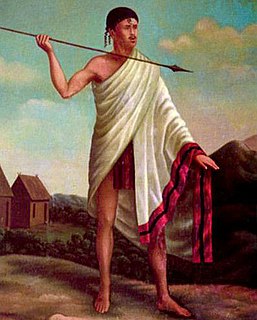Related Research Articles

The history of Madagascar is distinguished clearly by the early isolation of the landmass from the ancient supercontinent containing Africa and India, and by the island's late colonization by human settlers from the Sunda islands and from East Africa. These two factors facilitated the evolution and survival of thousands of endemic plant and animal species, some of which have gone extinct or are currently threatened with extinction due to the government not allocating resources to help the growing population, causing many people to resort to harmful environmental practices as a way of survival. Trade in the Indian Ocean at the time of first colonization of Madagascar was dominated by large ships, called Djong, coming from Java and Sumatra.

Ferdinand VII was the King of Spain during the early- to mid-19th century. He reigned over the Spanish Kingdom in 1808 and again from 1813 to his death in 1833. He was known to his supporters as el Deseado and to his detractors as el ReyFelón.

The French East India Company was a colonial commercial enterprise, founded on 1 September 1664 to compete with the English and Dutch trading companies in the East Indies.

Elisabeth Farnese was Queen of Spain by marriage to King Philip V. She exerted great influence over Spain's foreign policy and was the de facto ruler of Spain from 1714 until 1746. From 1759 until 1760, she governed as regent.

Dona Maria II "the Educator" or "the Good Mother", reigned as Queen of Portugal from 1826 to 1828, and again from 1834 to 1853. Born in Rio de Janeiro, she was the first child of Emperor Dom Pedro I of Brazil and Empress Dona Maria Leopoldina, and thus a member of the House of Braganza. One of the two surviving children born when Pedro was still heir apparent to Portugal, she inherited Portuguese titles and was placed in the line of succession to the former Portuguese throne, even after becoming a member of the Brazilian Imperial Family, from which she was excluded in 1835 after her definitive ascension to the Portuguese throne.

Emperor of the French was the title of the monarch of the First and the Second French Empires.

Fort-Dauphin, in Malagasy also used: Tolagnaro or Taolagnaro, is a city on the southeast coast of Madagascar. It is the capital of the Anosy Region and of the Taolagnaro District. It has been a port of local importance since the early 1500s. A new port, the Ehoala Port was built in 2006–2009. Fort-Dauphin was the first French settlement in Madagascar.

Andrianampoinimerinā (1745–1810) ruled the Kingdom of Imerina on Madagascar from 1787 until his death. His reign was marked by the reunification of Imerina following 77 years of civil war, and the subsequent expansion of his kingdom into neighboring territories, thereby initiating the unification of Madagascar under Merina rule. Andrianampoinimerina is a cultural hero and holds near mythic status among the Merina people, and is considered one of the greatest military and political leaders in the history of Madagascar.
Jean Fonteneau, dit Alfonse de Saintonge or João Afonso in Portuguese was a Portuguese navigator, explorer and corsair, prominent in the European age of discovery. He had an early career in Portugal and later served the King of France.

Rainilaiarivony was a Malagasy politician who served as the prime minister of Madagascar from 1864 to 1895, succeeding his older brother Rainivoninahitriniony, who had held the post for thirteen years. His career mirrored that of his father Rainiharo, a renowned military man who became prime minister during the reign of Queen Ranavalona I.
Andriambelomasina was a Merina King of Imerina Avaradrano, the northern part of the central highlands of Madagascar. The kingdom's capital was located at Ambohimanga.

Anosy is one of the 22 regions of Madagascar. It is located in the southeast of the country, on the eastern side of what was once the Toliara Province. The name Anosy means "island(s)" in Malagasy.

Andriana refers to both the noble class and a title of nobility in Madagascar. Historically, many Malagasy ethnic groups lived in highly stratified caste-based social orders in which the andriana were the highest strata. They were above the Hova and Andevo (slaves). The Andriana and the Hova were a part of Fotsy, while the Andevo were Mainty in local terminology.

The Merina Kingdom, or Kingdom of Madagascar, officially the Kingdom of Imerina, was a pre-colonial state off the coast of Southeast Africa that, by the 19th century, dominated most of what is now Madagascar. It spread outward from Imerina, the Central Highlands region primarily inhabited by the Merina ethnic group with a spiritual capital at Ambohimanga and a political capital 24 km (15 mi) west at Antananarivo, currently the seat of government for the modern state of Madagascar. The Merina kings and queens who ruled over greater Madagascar in the 19th century were the descendants of a long line of hereditary Merina royalty originating with Andriamanelo, who is traditionally credited with founding Imerina in 1540.

The Antanosy is a Malagasy ethnic group who primarily live in the Anosy region of southeastern Madagascar, though there are also Antanosy living near Bezaha, where some of the Antanosy moved after the Merina people conquered Anosy. An estimated 360,000 people identify as Antanosy as of 2013.
Andrianjaka reigned over the Kingdom of Imerina in the central highlands region of Madagascar from around 1612 to 1630. Despite being the younger of King Ralambo's two sons, Andrianjaka succeeded to the throne on the basis of his strength of character and skill as a military tactician. The most celebrated accomplishment of his reign was the capture of the hill of Analamanga from a Vazimba king. There he established the fortified compound (rova) that would form the heart of his new capital city of Antananarivo. Upon his orders, the first structures within this fortified compound were constructed: several traditional royal houses were built, and plans for a series of royal tombs were designed. These buildings took on an enduring political and spiritual significance, ensuring their preservation until being destroyed by fire in 1995. Andrianjaka obtained a sizable cache of firearms and gunpowder, materials that helped to establish and preserve his dominance and expand his rule over greater Imerina.
Andriantsimitoviaminiandriana Andriandrazaka was King of Avaradrano in the central highlands of Madagascar from 1710 to 1730, and King of neighboring Ambohidrabiby after defeating his brother, Andrianavalonimerina. He was a son of Andriamasinavalona, sovereign of the former Kingdom of Imerina, and his wife Ratompoindraoandriana. Sometime during his life Andriantsimitoviaminiandriana adopted Rakotomavo, who would later succeed him as King Andriambelomasina.

The Antankarana are an ethnic group of Madagascar inhabiting the northern tip of Madagascar, around Antsiranana. Their name means "the people of the tsingy," the limestone rock formations that distinguish their traditional territory. The tsingy of the Antankarana may be visited at the Ankarana Reserve. There are over 50,000 Antakarana in Madagascar as of 2013.

Christianity in Madagascar is practiced by 85.3% of Madagascar's population according to the Pew Research Center in 2010, often in syncretic form with traditional religious practices. Protestantism was introduced by the first envoys of the London Missionary Society in 1818, who proselytized and taught literacy through a Malagasy language Bible at the public schools they established in the highlands at the request of King Radama I. The number of converts remained low but gradually grew under repression during the reign of his successor, Queen Ranavalona I, and the more permissive religious policies of her son, Radama II, and his widow, Queen Rasoherina.